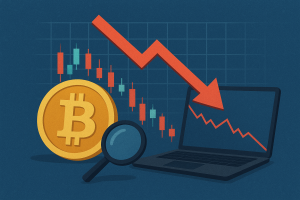Introduction
The cryptocurrency market has evolved significantly over the past decade, moving from a niche asset class to a mainstream investment vehicle attracting institutional investors. With the market’s increasing maturity, trading strategies have become more sophisticated, driven by both retail and institutional participation. Renowned analyst Eric Balchunas has provided deep insights into these changes, highlighting the role of institutional investors, algorithmic trading, and evolving regulatory landscapes.
This article delves into Balchunas’ views on the current state of cryptocurrency trading, the impact of institutional investors, and the emerging strategies shaping the market in 2025.
The Rise Of Institutional Investors In Cryptocurrency Trading
1. Institutional Interest in Crypto Markets
Over the past few years, institutional investors have significantly increased their involvement in cryptocurrency trading. This shift is driven by:
Growing Regulatory Clarity: Governments and regulatory bodies worldwide are establishing clearer frameworks for cryptocurrency investments.
Bitcoin ETFs and Investment Products: The approval of Bitcoin exchange-traded funds (ETFs) has provided traditional investors with a regulated and accessible way to invest in crypto assets.
Hedge Funds and Asset Managers: Large financial institutions like BlackRock, Fidelity, and Goldman Sachs have incorporated crypto trading into their portfolios, signaling mainstream adoption.
Eric Balchunas highlights that institutional investors now view cryptocurrencies as an essential part of a diversified portfolio, rather than a speculative asset. The introduction of structured financial products has made digital assets more appealing to conservative investors.
2. Impact of Institutional Investors on Market Stability
One of the biggest changes in the cryptocurrency market is the increase in market stability due to institutional participation. While crypto assets were once infamous for extreme volatility, institutional investors bring:
Liquidity: Large capital inflows reduce bid-ask spreads, making the market more efficient.
Long-Term Holding Strategies: Unlike retail traders who often react impulsively to price swings, institutions take a long-term approach, reducing market panic.
Regulatory Compliance: Increased institutional participation encourages exchanges to adopt stricter compliance measures, reducing risks associated with fraud and manipulation.
Balchunas points out that institutional investors’ presence has led to a significant decline in flash crashes and unpredictable price swings.
Emerging Cryptocurrency Trading Strategies In 2025
1. Algorithmic and High-Frequency Trading (HFT)
Institutional investors and hedge funds have embraced algorithmic trading, leveraging advanced AI-driven models for:
Arbitrage Trading: Taking advantage of price discrepancies between exchanges.
Market-Making Strategies: Providing liquidity while earning from bid-ask spreads.
Sentiment Analysis: Using AI to analyze market sentiment based on social media, news trends, and blockchain data.
Eric Balchunas emphasizes that the adoption of machine learning and AI-driven trading bots has given institutions a significant edge over retail traders, increasing efficiency in crypto markets.
2. Derivatives and Options Trading
Another key trend is the rise of derivatives and options trading in crypto markets. Institutional investors use these instruments to:
Hedge Risk: Protect portfolios against sudden market downturns.
Leverage Exposure: Gain larger positions without directly buying the underlying asset.
Enhance Yield: Generate income through covered calls and put strategies.
The Chicago Mercantile Exchange (CME) and Binance Futures have reported record-high options trading volumes, showing that institutions are deeply involved in these markets.
3. Smart Contract-Based Trading Strategies
The rise of DeFi (Decentralized Finance) has enabled smart contract-based trading strategies that include:
Automated Yield Farming: Using smart contracts to automatically shift funds between liquidity pools for optimal returns.
Lending and Borrowing Strategies: Institutions are now using DeFi protocols like Aave and Compound to access on-chain loans, leveraging their crypto holdings.
Decentralized Exchange (DEX) Arbitrage: Taking advantage of price discrepancies across different blockchain ecosystems.
Balchunas notes that the integration of DeFi with traditional finance is accelerating, making it an essential component of crypto trading.
Key Trends Shaping Cryptocurrency Trading In 2025
1. Institutional Custody Solutions
One of the biggest challenges institutions face is secure asset storage. The emergence of institutional-grade custody solutions such as:
- Coinbase Custody
- Fidelity Digital Assets
- Anchorage Digital
has given large investors confidence in holding digital assets. These platforms offer multi-signature security, insurance coverage, and regulatory compliance, reducing concerns about hacks and security breaches.
2. Tokenization of Traditional Assets
The tokenization of real-world assets, including stocks, bonds, and real estate, has become a major trend. Institutions are now trading:
- Tokenized Stocks on platforms like Binance and FTX.
- Blockchain-Based Bonds issued by governments and corporations.
- Real Estate NFTs, allowing fractional ownership of properties.
- This shift is creating a bridge between traditional finance and decentralized finance (DeFi).
3. Expansion of Stablecoin Use Cases
Stablecoins like USDC, USDT, and DAI have gained institutional acceptance as a reliable medium for settlements, remittances, and trading. Eric Balchunas highlights that stablecoins now play a crucial role in:
- Cross-Border Transactions: Reducing transfer costs and settlement times.
- On-Chain Trading Pairs: Serving as the backbone for liquidity in DeFi markets.
- Hedging Against Volatility: Institutions use stablecoins to mitigate market risk while staying within the crypto ecosystem.
The Regulatory Landscape And Future Outlook
1. Stricter Regulations and Compliance
Governments and regulatory bodies are imposing stricter compliance measures to protect investors. Key developments include:
- MiCA (Markets in Crypto-Assets) Regulations in Europe.
- SEC Oversight on Crypto ETFs in the U.S.
- Stronger KYC/AML Policies enforced on exchanges and DeFi platforms.
Balchunas points out that while regulations may seem restrictive, they actually encourage institutional adoption by providing legal clarity.
2. The Role of Central Bank Digital Currencies (CBDCs)
CBDCs are expected to revolutionize the financial sector, with major economies testing digital versions of their fiat currencies. The impact on crypto trading includes:
- Increased Integration Between Crypto and Traditional Finance
- Faster Settlement Times for Large Transactions
- Reduced Need for Intermediaries in Cross-Border Payments
Eric Balchunas believes that while CBDCs won’t replace cryptocurrencies, they will complement them, offering seamless interoperability.
Conclusion
The cryptocurrency market in 2025 is vastly different from its early days, with institutional investors playing a dominant role. Eric Balchunas’ insights reveal that institutions are shaping the market through advanced trading strategies, regulatory compliance, and increased liquidity.
As cryptocurrency trading continues to evolve, retail and institutional investors alike must adapt to new trends, ensuring they stay ahead in this dynamic financial landscape.



